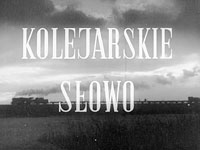 Kolejarskie słowo
Kolejarskie słowo
Poland, 1953, black and white, 22 mins
The Railwayman’s Word is one of those films that needs a certain amount of historical contextualisation, as its innovations are far less apparent today than they would have been back in 1953, the year of Stalin’s death, and long before any cultural thaw. For all its mild unorthodoxies in its semi-fictionalisation of real-life events, it still falls squarely within the genre of Socialist Realism, with a propagandist narrative built around the heroic railway workers ensuring that the chartered delivery from the Silesian coking plants to the Szczecin steelworks runs smoothly. The coke’s function in literally fuelling a productive economy is stressed from the outset, with Andrzej Łapicki’s soft-spoken narration delivered over dynamic shots of steelworkers wrestling with the elements amid flying sparks and rivulets of molten metal.
From the start, it’s stressed that this is “an ordinary story, such as may take place every day”, and what’s most striking about writer-director Andrzej Munk’s approach is that he uses a wide range of cinematic devices to add interest, suspense and even excitement to what are ostensibly utterly routine events. The junction at Tarnowskie Gory (later the subject of Kazimierz Karabasz’ more poeticised Railway Junction/Węzeł in 1961) prepares the engines for their various tasks (steel to Warsaw, coal to Łódź, iron to Gdansk and coke to Szczecin). Without resorting to tacky anthropomorphism, Munk shows how the railwaymen treat their engines as though they were somehow alive, and will return to a visual motif of the locomotive’s water-meter (“the heart of every steam engine – water is like its blood”) on several occasions throughout the film. The other key motif is that of the warranty certificate, the “railwayman’s word” of the title – a written guarantee, signed by various hands, that the train is fit for its designated purpose, the finished document inserted into its own proprietary frame on the side of the engine and held in place behind a metal grille.

Next comes the dispatching process, the entire subject of Karabasz’ film, though given briefer treatment here as we catch only occasional glimpses of the complex logistics that they have to wrestle with to ensure that they don’t, as the commentary puts it, “lose a train”. The remaining three-quarters of the film follows the progress of warranted coke train no. 49281 as it passes various stages en route from Silesia to Szczecin, with telephoned reports on the progress of it and all the other trains in the region constantly relayed back to the dispatchers and forwarded to their colleagues further along the track.
The film’s central drama derives from the obstacles that 49281 encounters en route, from an unscheduled uncoupling to a rail being replaced. Every delay has a knock-on effect, with the dispatchers having to reschedule multiple trains on the hoof, and ensure that all changes of information are passed on to everyone from the signallers to the train crews. Much of the middle section of the film has little spoken content, either onscreen or from Łapicki’s narration: instead, Munk favours a blend of natural train sounds overlaid with Jan Krenz’s score, its driving rhythms matched by pacy editing, with frequent cutaways to clocks to emphasise the inexorable passage of time. There’s one particularly dramatic cut to a warning signal – accompanied by a jarring brass chord – that makes one momentarily forget the film is in black and white, as the signal’s redness practically leaps out of the screen.
A comparison could be made with the work that Alberto Cavalcanti and Benjamin Britten did on the classic British GPO Film Unit documentaries such as Coal Face (1935) and Night Mail (1936), though Munk’s film ultimately lacks their poetic force and abiding interest in the human element. This is particularly marked in the treatment of the workers: in Night Mail, we eavesdrop on a great deal of casual banter, whereas Munk’s railwaymen are completely focused on the job, saying nothing out of turn. On the other hand, Munk probably wouldn’t have had the freedom that Basil Wright and Harry Watt enjoyed to toss in quirky asides – at least not without having to justify them to a po-faced censor.

What’s far more successful is Romuald Kropat’s photography, favouring imposing low-angle shots of the trains both in motion and at rest, when they’re backlit in a way that emphasises the steam, as though they’re sweating copiously after a hard day’s effort. There are also silent close-ups of the workers’ faces, often chiselled into sharp relief by high-contrast lighting, expressions generally serious, though there’s a brief interlude when two small girls wave at the driver and he responds in kind. But these moments are few and far between: group effort and co-operation is still very much the name of this particular game.
- Director/script: Andrzej Munk
- Camera: Romuald Kropat
- Editing: Jadwiga Zajiček, Maria Orłowska
- Narration: Karol Małcużyński
- Voice-Over: Andrzej Łapicki
- Sound: Zbigniew Wolski
- Music: Jan Krenz
- Production Manager: Jan Lubieniecki
- Production Company: Wytwórnia Filmów Dokumentalnych (Documentary Film Studio)
The film is included on PWA’s Polish School of the Documentary: Andrzej Munk double-DVD set (Region 0 PAL). The source print is marred by low-level damage and near-continuous exposure fluctuations – it’s definitely a notch below the two earlier Munk films on the same disc, though this never seriously affects appreciation. However, the soundtrack is a marked improvement on its predecessors – still plain mono, and with a limited dynamic range characteristic of an early 1950s recording, it nonetheless does a very impressive job of blending narration, train sounds and onscreen and offscreen voices. The subtitles, too, are perfectly adequate, with just a couple of minor typos. Online commentary is provided by this Culture.pl overview of Munk’s career, which discusses The Railwayman’s Word in some detail.